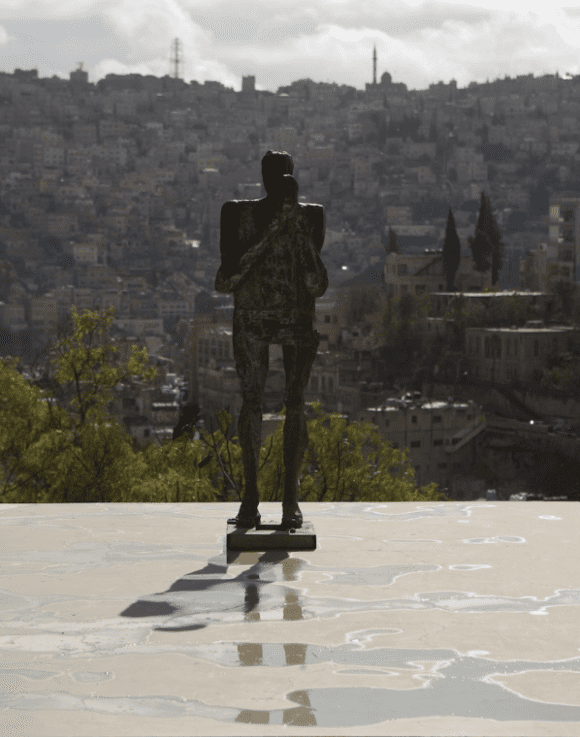 Darat al-Funun
Darat al-Funun


Darat al-Funun (meaning ‘home for the arts’ in Arabic) is a non-profit foundation conceived as a platform for contemporary Arab artists, under the patronage of the Khalid Shoman Foundation. In addition to supporting art practices and artistic exchanges, Darat al-Dunun offers an environment to stimulate critical discourse, and to research, document and archive Arab art.
Located in Amman’s Jabal al-Lweibdeh district, the foundation comprises six renovated historic buildings, an archeological site adorned by the ruins of a sixth-century Byzantine church, shops, and warehouses. Particularly, the spaces are called the Main Building, the Library, the Archaeological Site, the Blue House, Dar Khalid, the Façade, the Headquarters, the Lab, Beit al Beiruti – The Museum, and the Residency Building.
The history of Darat al-Funun dates back to 1988, when it was first founded as a centre by Suha Shoman—an artist and a student of Fahrelnissa Zeid—, originally as part of the Abd al-Hamid Shoman Foundation. Established out of a cultural urgency, the initiative was introduced to support art and artists hailing from Jordan and the Arab world, to activate dialogue with artists via residencies, exhibitions, exchanges, and lectures.
The context of its establishment is very peculiar, the centre was born during uncertain times of war and conflict in the region. Similarly, Jordan received waves of refugees from neighbouring countries who were looking for safety and stability. While Jordan prioritised asylum seekers, infrastructure, and its nation-building, it neglected art and culture that became less of a priority. Therefore, private foundations have emerged to support the arts in the country. Naturally, Darat al-Funun became a safe haven for artists enduring difficult and political circumstances. Namely, Palestinian artists who experienced the first Intifada (1987-1993), Iraqi artists who seeked shelter during the Gulf war (1990-1991), and Lebanese artists who endured the civil war (1975-1990).
During the first years, the centre held talks, programmes, and solo and group exhibitions. They included the inaugurating exhibition that assembled eight Jordanian artists, followed by exhibitions for artists from Northern Africa (in collaboration with l’Institut du monde arabe), Iraqi artists (in conversation with Saddam Art Center, now renamed the Iraqi Museum of Modern Art), German artists (with the Goethe Institute), Iraqi artist Shakir Hassan Al Said’s solo exhibition, and Palestinian artists.
The first five successful years led the foundation to conceive its ‘Main Building’ in 1993, with an inaugural exhibition featuring 50 Arab contemporary artists. The main building housed all of Darat al-Funun’s activities, with a space for exhibitions, workshops, and a library. Additionally, an archeological site was designated for performances, concerts, and other artistic expressions. Concurrently, a second building called ‘Blue House’ was launched the following year as an extension, to house exhibitions and a café in its garden. Finally, a third building ‘Dar Khalid’ was renovated in 1995 to welcome artists-in-residence in its quarters.
Darat al-Funun was one of the very first Arab foundations dedicated to art to launch a website, and go online in 1997. It continued its activities of group and solo exhibitions, residencies, retrospectives, talks, publications, and performances. Moreover, the foundation expanded its programmes by involving artists to lead and mentor. For instance, Syrian artist Marwan Kassab-Bachi directed Darat al-Funun’s ‘Summer Academy’, from 1999 to 2003. He offered an intensive course on painting that grouped emerging Jordanian, Palestinian, Syrian, Lebanese, and Iraqi artists under his mentorship.
Presently, the collection of the foundation is housed in three of the six renovated historic buildings of the foundation. The Museum: Art Architecture Archeology is housed in Beit al Beiruti, where the three A’s intersect and merge. It embodies the long 30+ years journey of Darat al Funun, in support of the arts, culture, and architectural heritage in Jordan and the Arab world.
To learn more about Darat al-Funun, visit their website.
Image courtesy of Darat al-Funun.


 Darat al-Funun
Darat al-Funun 
